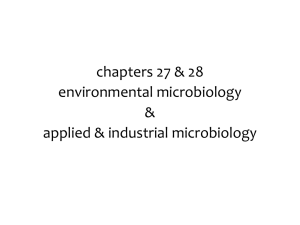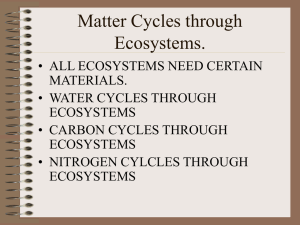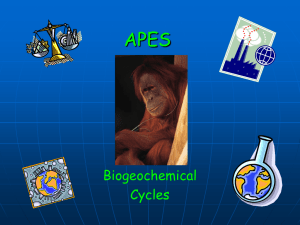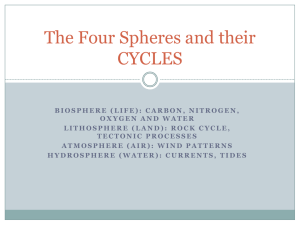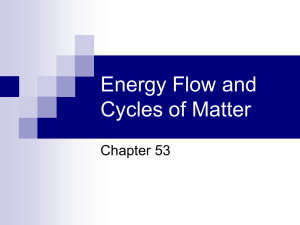Lecture Slides for Biogeochemical Cycles 311
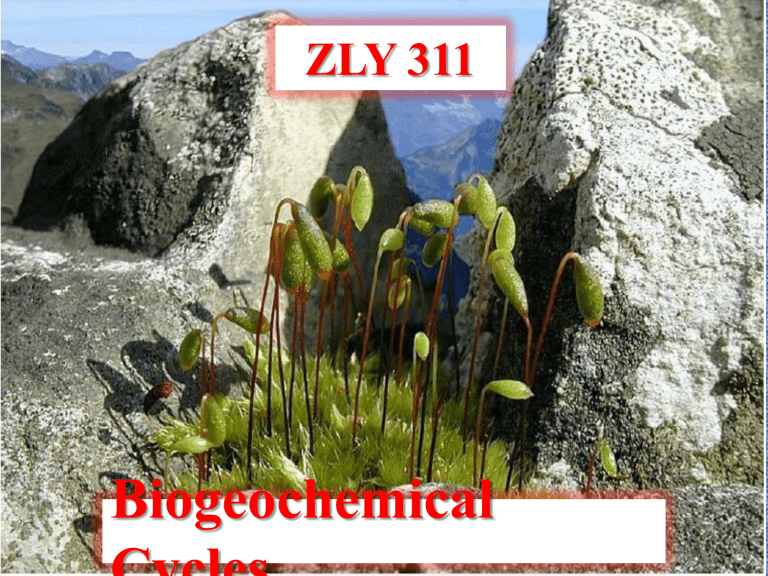
ZLY 311
Biogeochemical
Cycles
Introduction
Living things require various kinds of chemical elements for their synthetic and metabolic processes.
Energy, water & many elements cycle through ecosystems and influence growth & reproduction.
About 10 major nutrients and six trace nutrients are essential to all animals and plants.
Carbon, hydrogen, nitrogen and oxygen form the basic constituent components of carbohydrates, fats and proteins.
Introduction
All these elements with phosphorus form nucleic acids.
Sulphur is essential for the formation of amino acids,
magnesium for chlorophyll biosynthesis,
phosphorus for transformation of energy through cells,
calcium for strengthening cell walls,
potassium highly indispensible for growth,
iron molybdenum and copper for the activity of certain enzymes and so on.
The aforementioned elements constitute the basic building blocks of the protoplasm.
Introduction
The absorption and utilization of these elements by organisms is compensated by their recycling and regeneration back into the environment by the breakdown of these organic compounds.
The more or less cyclic path of these elements in the biosphere, i.e. from environment to organisms and back to the environment is described as biogeochemical cycles.
Biogeochemical Cycles & the Ecosphere
•
The global ecosphere is the thin film around the earth where the biosphere interact with the atmosphere, hydrosphere, cryosphere and lithosphere in a complex system involving biological, geological, and chemical processes and cycles (Next slide).
•
This biogeochemical system of spheres and processes is powered mainly by energy from the sun.
•
The ecosphere is made up of individual ecosystems, such as tropical forests, grasslands, tundra, coral reefs, and estuaries.
•
Matter and energy flow between and within these ecosystems occurs in interconnected biogeochemical cycles.
Biogeochemical Cycles & the Ecosphere
Biogeochemical Cycles & the Ecosphere
In the ecosystem, gaseous chemical compounds are produced, consumed & exchanged in the air.
In the atmosphere, they may react to form other compounds before returning to the earth’s surface.
Some of these chemical compounds are greenhouse gases viz; CO
2
, CH
4
.
They act in the atmosphere to warm the planet.
Others, like dimethyl sulphide gas, react with other atmospheric chemicals to form minute airborne particles (aerosols) that directly or indirectly help to cool the climate.
Biogeochemical Cycles Pitfalls
Certain factors are difficult to describe:-
1. Irreversibility : The system does not return to its exact previous state if it goes through a disturbance;
2. Transitional phenomena : The system tends to switch from one state to another and perhaps back again, rather than simply moving from “before” to
“after”;
3. Evolution: The system progressively changes in a particular direction; a) Positive feedback: Enhance the original perturbation to the system b) Negative feedback: Relieve the perturbation .
Essentials of Biogeochemical Cycles
•
Many elements enter living systems in the gaseous state from the atmosphere or as water soluble salts from the soil.
•
As the flux of these elements through an ecosystem gives some measure of its continuity and productivity, the analysis of exchange of various components of the biosphere is essential.
•
Furthermore society depends upon this lifesupport system of the earth for sustained and increased production of food, fodder, fibre and fuel.
Key Points in Biogeochemical Cycles
Major reservoirs: part of a system that can store or accumulate and be a source of one of the substances that compose the system.
Fluxes: Movement of a variable or a substance into or out of a reservoir.
Oxidation states of elements: Biogeochemical cycles primarily represent changes in oxidation states.
Chemical properties of various molecular species,
Magnitude of human impacts,
Biogeochemical Cycles & the Ecosphere
•
The global ecosphere is the thin film around the earth where the biosphere interact with the atmosphere, hydrosphere, cryosphere and lithosphere in a complex system involving biological, geological, and chemical processes and cycles (Next slide).
•
This biogeochemical system of spheres and processes is powered mainly by energy from the sun.
•
The ecosphere is made up of individual ecosystems, such as tropical forests, grasslands, tundra, coral reefs, and estuaries.
•
Matter and energy flow between and within these ecosystems occurs in interconnected biogeochemical cycles.
Hydrologic Cycle
Water Cycle is described as the journey water takes as it circulates from the land to the sky and back again.
This biogeochemical system of spheres and processes is powered mainly by energy from the sun.
Water is by far the most important substance necessary for all life forms.
It determines the structure and function of the ecosystem and regulates the plant environment to a large extent.
Hydrologic Cycle
Importance of Water
1. The cycling of all other elements is also dependent on water, because it provides the solvent medium for their uptake.
2. It provides H
+ photosynthesis.
for reduction of CO
2 during
3. It has moderating effect on temperature of the environment by virtue of its heat absorbing ability.
4. The protoplasm described as the basis of life is primarily composed of 85 to 95% water.
5. Water content from organism to organism varies and it is often marked by their needs e.g. human blood is
90% water.
Hydrologic Cycle
Water cycle involves an exchange of water between the earth’s surface and the atmosphere via precipitation and evapo-transpiration.
It covers about 75% of the earth surface, occurring in lakes, ponds, rivers, seas, oceans etc.
The ocean occupies 70% of the surface and contains approximately 97% of all the water on the earth.
The remainder is left as frozen in ice caps and glaciers.
Hydrologic Cycle
The water in rivers and lakes is comparatively small. Less than 1% is in the form of ice-free freshwaters in rivers, lakes and aquifers.
This negligible volume of the planet’s water is crucially important to all forms of terrestrial and aquatic life.
Water is also trapped underground, and soils near the surface also serve as reservoirs for enormous quantity of water.
Hydrologic Cycle
Hydrologic Cycle
•
Heat from the sun warms the ocean and land surfaces and causes water to evaporate.
•
Water vapour enters circulation of the air.
•
On a global scale, warm air rises in the atmosphere and cooler air descends.
•
The water vapour rises with the warm air.
•
The farther from the warm planetary surface the air travels, the cooler it becomes.
•
Cooling causes water vapour to condense on small particles (cloud condensation nuclei) in the atmosphere and to precipitate as rain, snow, or ice and fall back to the earth’s surface.
Hydrologic Cycle
•
When the precipitation reaches the land surface, it is evaporated directly back into the atmosphere, runs off or is absorbed into the ground, or is frozen in snow or ice. Some of the precipitation soaks into the ground.
•
Some of the underground water is trapped between rock or clay layers (groundwater).
•
Most of the water flows downhill as runoff (above ground or underground), eventually returning to the seas as slightly salty water.
Hydrologic Cycle
Hydrologic Cycle
•
Water cycle is being significantly affected by water usage and contamination of water stocks.
•
Currently, humans use an amount of water equivalent to about 25% of total terrestrial evapotranspiration and 55%, or 6,800 cubic kilometers per year, of the runoff of water from the continents that is accessible, only about 20% of the world’s drainage basins have pristine water quality.
The Nitrogen Cycle
•
Nitrogen forms part of the molecules that make up living things, such as amino acids (building blocks of proteins) and DNA.
•
The nitrogen in proteins bonds together with various amino acids to form the protein structure.
•
Amount of nitrogen in the atmosphere is very large compared to that in the oceans or rocks.
•
Of the elements C, N, P, S, and O, only nitrogen is found in more abundance in the atmosphere than in rocks.
The Nitrogen Cycle
6 major forms of atmospheric nitrogen, viz;
1. the gaseous forms of diatomic nitrogen (N
2
),
2. Ammonia (NH
3
),
3. Dinitrogen oxide (N
2
O),
4. NO x
(NO and NO
2
),
5. The aerosols of ammonium (NH
4
+) and
6. Tri-oxo-nitrate (V) (NO
3
-).
The Nitrogen Cycle
•
Nitrogen and phosphorus are two of the most essential mineral nutrients for all types of ecosystems and often limit growth if they are not available in sufficient quantities.
•
This is why the basic ingredients in plant fertilizer are nitrogen, phosphorus, and potassium, commonly abbreviated as NPK.
•
A slightly expanded version of the basic equation for photosynthesis shows how plants use energy from the sun to turn nutrients and carbon into organic compounds:
The Nitrogen Cycle
•
The basic equation for photosynthesis shows how plants use energy from the sun to turn nutrients and carbon into organic compounds:
CO
2
O
2
+ PO
4
+ NO
3
+ H
2
O → CH
2
O, P, N (organic tissue) +
•
Atmospheric nitrogen (N
2
) is inert and cannot be used directly by most organisms, therefore, microorganisms that convert it into usable forms of nitrogen play central roles in the nitrogen cycle.
•
Crucial to the use of nitrogen by most living things is the ability of breaking the N-N triple bond, which is known as “nitrogen fixation”.
The Nitrogen Cycle
•
Nitrogen fixation is accomplished by nitrogen-fixing bacteria that contain a metallo-enzyme known as nitrogenase , by lightening, and by human industry.
•
Most organisms can only assimilate “fixed” nitrogen in the form of ammonia or nitrate.
•
These microorganisms take inert nitrogen (N
2
) from the atmosphere and convert it to ammonia nitrate
(NH
4
NO
3
) and another nitrogen compound, which plants utilize.
•
Some of these bacteria live in mutualistic relationships in the roots of plants, mainly legumes (peas and beans), and provide nitrogen directly to the plants.
The Nitrogen Cycle
•
At the back end of the cycle, decomposers break down dead organisms and wastes, converting organic materials to inorganic nutrients.
•
Other bacteria carry out denitrification , breaking down nitrate to gain oxygen and returning gaseous nitrogen to the atmosphere.
The Nitrogen Cycle
The Nitrogen Cycle
•
Part of the modern global biogeochemical cycle of nitrogen, emphasizing interactions among the land, atmosphere, and ocean (Next Slide).
•
Fluxes between the ocean, land, and groundwater are shown as arrows; with quantities given in million tons of nitrogen per year (Mt N/yr.).
•
Fluxes within reservoirs are shown as circling arrows.
“Ind. fix” is industrially fixed N (for the manufacture of fertilizers),
• “Bio. fix” is biologically fixed N, DN is dissolved N,
PON is particulate organic nitrogen, and “pollutant” is the excess nitrogen that has resulted from human activities.
The Nitrogen Cycle
The Nitrogen Cycle
Major Processes leading to Exchange of Nitrogen:
1. Biological fixation is the process whereby N
2 is withdrawn from the atmosphere and converted to N compounds that plants can use (e.g., NH subsequently NO
3
-).
3 and
2. Denitrification is the process by which nitrogen as
N
2 or as N
2
O is returned to the atmosphere.
3. On a global scale, rivers may already carry more nitrogen from human activities than was transported in the natural state.
4.
The Nitrogen Cycle
•
This increased nitrogen flux to lakes, rivers, and coastal marine environments are one cause of increased regional and global eutrophication.
•
Rivers supply only a small percentage of nitrogen to the coastal zone (Next Slide). Most of the nitrogen there, other than that recycled in the zone, upwelled from the deep ocean to the surface.
The Nitrogen Cycle
The Nitrogen Cycle
•
River input of N to the ocean compared to the fluxes involved with the internal recycling of N in the ocean is due to biological productivity and decay.
•
Besides ocean fluxes, almost 90% of N involved in biological production is simply recycled in the shallow surface waters of the coastal and open oceans.
•
Some nitrogen escapes from the surface ocean as organic matter and settles at the benthos of the ocean, where they decay and nitrogen is released.
The Dinitrogen Oxide Flux
The Dinitrogen Oxide Flux
•
N
2
O is a natural product of biological denitrification in soils and in the ocean.
•
The N
2
O produced by denitrification is only about
15% of all N returned to the atmosphere.
•
N
2
O is an important greenhouse gas, accounting for about 9% of the enhanced greenhouse effect.
•
Presently, atmospheric concentration is 312 parts per million volume (ppmv) and a residence time of about
130 years.
•
This concentration is about 8% greater than in preindustrial time and is increasing at a rate of 0.2–0.3% per year because of anthropogenic activities,
The Dinitrogen Oxide Flux
•
These activities includes combustion of fossil fuels, burning of biomass and emissions from urea and ammonium nitrate applied to crop lands. These emissions amount to 0.13 to 2.8 million tons of nitrogen annually.
•
N
2
O is chemically inert in the troposphere.
•
In the stratosphere, N
2
O is converted photochemically to nitric oxide (NO), which acts as a catalyst in the destruction of stratospheric ozone
•
The series of reactions by which this is accomplished has been one of the regulators of stratospheric ozone concentration through geologic time.
Destruction of Stratospheric Ozone Layer
The Dinitrogen Oxide Flux
•
The flux of N
2
O from the earth to the atmosphere has been increasing because of anthropogenic activities and increases in organic carbon in coastal waters.
•
Increase in organic carbon in coastal waters has formed an important link between the carbon and nitrogen cycles.
•
The rate of denitrification and N
2
O emissions from coastal waters may have increased because rivers are bringing more organic carbon to these systems anda re undergoing eutrophication as they receive increased inputs of nutrients from fertilizer, sewage, and the atmosphere.
Effect of N
2
O 0n Ecosphere
•
With warming, the most important biotic feedbacks involving N
2
O has lead to changes in the denitrification & nitrification rates in soils, sediments, and ocean water.
•
N
2
O fluxes from nitrogen-bearing fertilizers applied to the land surface and subsequent sewage discharges into aquatic systems will be affected by warming.
•
The reactions involving N
2
O are bacterially mediated, therefore an increase in temperature lead to enhanced evasion rates of N
2
O from the earth’s surface.
•
This is a positive biotic feedback on accumulation of N
2
O in the atmosphere ending with global warming.
•
It could also lead to a small enhanced destruction of stratospheric ozone.
The Ammonia Flux
•
Ammonia is released to the atmosphere by organic decomposition and volatilization.
•
There, it reacts with water droplets to form ammonium ion (NH
4
+) and hydroxyl ion (OH-).
•
NH
4
+ appears to be removed from the atmosphere mainly by being deposited back on the earth in the aerosols of ammonium tetra-oxo-sulphate (VI) [(NH
4
)
2
SO4] and ammonium tri-oxo-nitrate (V) (NH
4
NO
3
).
•
Incidentally, (NH
4
)
2
SO4 links the nitrogen and sulphur biogeochemical cycles, since its deposition on the earth is also one of the ways oxidized sulphur is removed from the atmosphere; the other is by deposition of tetra-oxosulphate (VI) acid (H
2
SO4).
The Ammonia Flux
The Ammonia Flux
Interactions involved in NH
3
Cycle affecting Global
Warming
•
NH
3 interacts with OH- to produce NOx.
•
In a warmer world; the decomposition that releases NH
3 is enhanced; this would slightly increase the stress on the
OH- concentration of the atmosphere and enhance production of NOx.
•
NH
3
’s reaction with NO containing ammonium.
3 and SO
4
2 - to produce aerosols
•
Aerosols are known to cool the planet, although the amount of the effect is unclear.
•
An increase in atmospheric NH
3 could lead to a small negative feedback on potential warming.
Summary
The most dramatic change in the nitrogen cycle is the amount of nitrogen humans now fix through industrial processes.
It is estimated that human activities have probably doubled the amount of nitrogen that is fixed per year.
Humans have also altered the concentration of nitrogencontaining compounds in the atmosphere.
Dinitrogen oxide (N
2
O) concentrations are increasing at a rate of about 0.2-0.3% per year.
Dinitrogen oxide is both a greenhouse gas and a cause of stratospheric ozone depletion.
Nitric oxide (NO) concentrations are also increasing.
About 80% of all NO emissions are caused by humans.
Summary
Nitric oxide contributes to photochemical smog and acid rain.
An increase in the amount of fixed nitrogen in the environment changes the composition of plants. Many ecosystems have historically been nitrogen-limited.
In some areas, nitrogen may no longer be limiting. Many aquatic ecosystems are visibly burdened by the high growth of plants and bacteria.
Nitrate in ground water can cause problems for infants who drink the water because inside their bodies they convert the nitrate to nitrite and nitrite binds to iron in hemoglobin, preventing oxygen from binding, which leads to suffocation.
Summary
Nitric acid is contributing to the acidification of aquatic ecosystems.
Anthropogenic activities add roughly as much nitrogen to terrestrial ecosystems each year as the amount fixed by natural processes
Excess nitrogen promotes algal blooms, which then deplete oxygen from the water when the algae die and decompose.
Additionally, airborne nitrogen emissions from fossil fuel combustion promote the formation of ground-level ozone, particulate emissions, and acid rain.




